Beijinho (Brazilian Coconut Balls)
One of Brazil’s popular party treats, Beijinhos are creamy, coconut-y and easy to make! Little bites of coconut bliss that are sure to transport you to tropical paradise with each delectable nibble. Whether you’re planning a party, a special occasion, or just want to treat yourself to something delicious, this Beijinho recipe is sure to become a favorite in your Brazilian desserts collection!
Beijinhos are the coconut cousins of brigadeiros! If you love these fudgy sweets, make sure to also check out my Brigadeiro Cake, Brigadeiro Ice Cream, Naked Cake with Raspberry Brigadeiro, Pumpkin Brigadeiros and Champagne Brigadeiro.
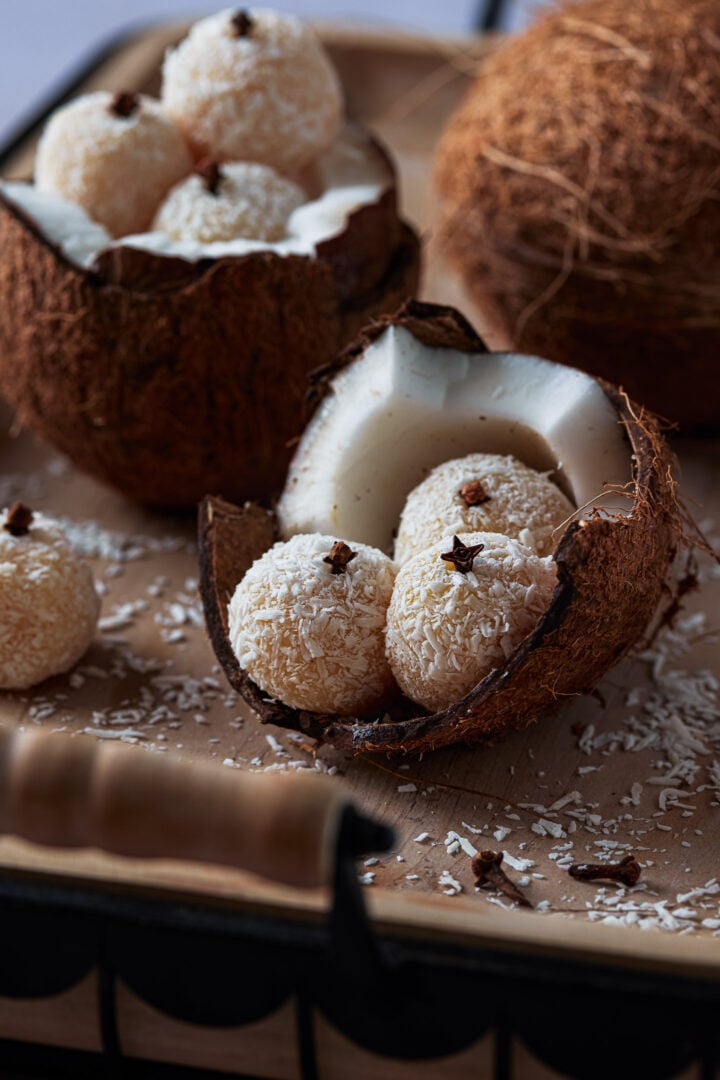
Oh how I miss a good Brazilian birthday party! If you’ve ever been to one, chances are you were impressed at the collection of treats that were displayed by the cake. Brigadeiro, bicho de pé, cajuzinho, olho de sogra and beijinho are only some of the many docinhos de festa (party sweets) that get everyone excited about attending those parties!
So I decided it was time I took you on a sweet escapade, through the delightful realm of beijinhos, filled with creamy wonders, a sprinkle of nostalgia, and a dash of Brazilian charm! So, buckle up and get ready to indulge in this whimsical journey of flavor and fun. Let’s unlock the secrets of this beloved Brazilian treat and discover why beijinho is the sweet sensation that will make you pucker up for another mouthwatering bite!
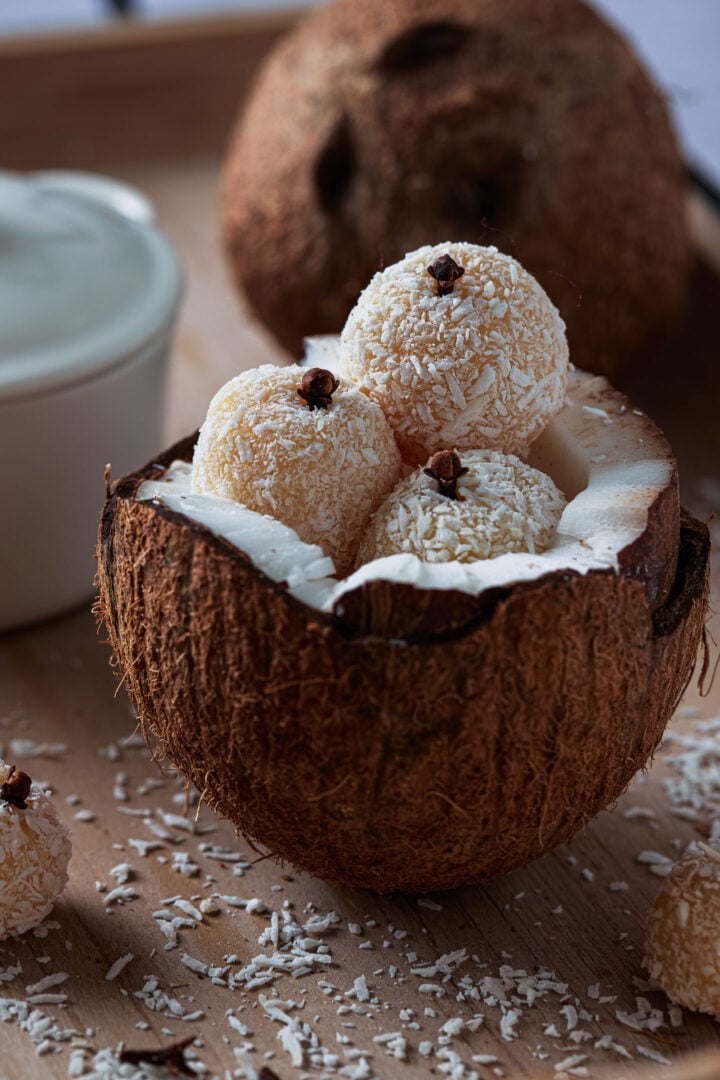
What is Beijinho?
Beijinho is a popular Brazilian treat, loved by both children and adults. It is a delightful coconut brigadeiro made with just a few simple ingredients, such as sweetened condensed milk, butter, and coconut.
The name “beijinho” translates to “little kiss” in Portuguese, which captures perfectly its bite-sized charm.
The roots of this treat can be traced to Portugal, where it was known as “beijo de freira” (nun’s kiss) – because it was made in convents – and made with almonds and a sugar syrup. When the Portuguese colonized Brazil, they brought this treat (along with many other Portuguese recipes), which was eventually adapted to include a popular Brazilian ingredient: coconut. Its name was then changed to “beijo de coco”.
Fast forward to the 20th century, when sweetened condensed milk was invented, and the recipe was adapted once more. It was only then that cloves were added as a decorative element and the name “beijinho” became widely used.
In Brazil, beijinhos are often served at parties, celebrations, and other special occasions. Whether it’s at a birthday party, a wedding, or any festive event, the sweet indulgent flavor of beijinho brings most Brazilians – this one included – a sense of nostalgia, making it a beloved treat in our culture.
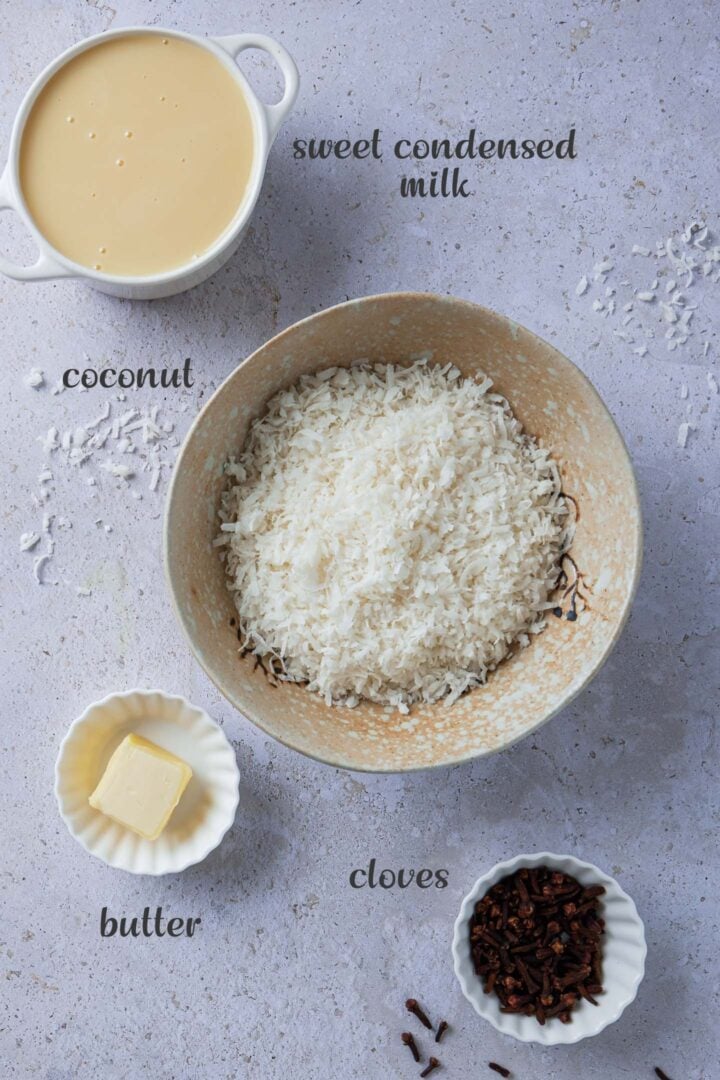
Ingredients
To make Beijinhos, you will need:
- Sweetened Condensed Milk – A key ingredient in beijinho and in lots of Brazilian desserts. It’s what gives these treats its creaminess and sweeteness. And since sweetened condensed milk is already sweet, I do not add any extra sugar to this beijinho recipe!
- Butter – Adding butter to beijinho makes it extra creamy and velvety.
- Coconut – You’ll need grated or shredded unsweetened coconut to make the beijinho mixture and also to decorate them. I have used the sweetened variety in a pinch, but I find that makes the beijinhos a bit too sweet to my taste!
- Whole Cloves – Most people believe cloves act only as a decorative element in beijinho, but that’s not entirely true. They also infuse the treats with a subtle hint of spiciness and warm aroma. That being said, if you’re not a fan of cloves, you can just leave them out.
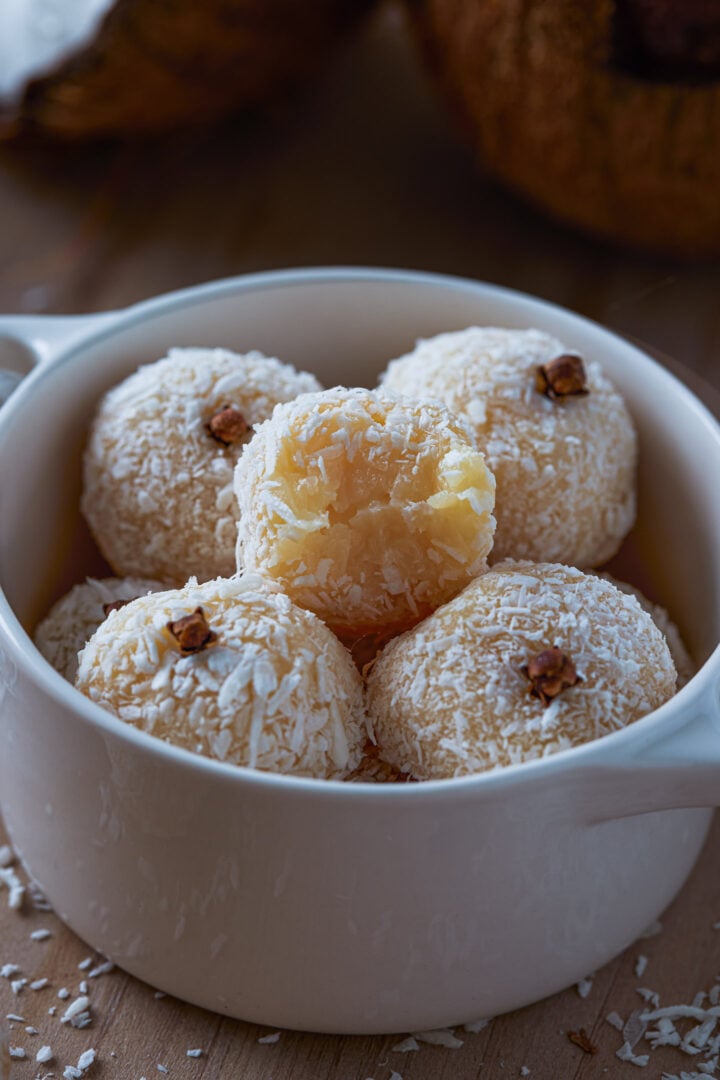
How to Make Beijinho
The simplicity of this recipe is one of the reasons why beijinhos are so popular in Brazil! It requires minimal ingredients and preparation time, making it accessible for all home cooks and a great option for those who want to whip up a delicious treat without spending hours in the kitchen.
Recommended tools and equipment: Dutch Oven (or saucepan), rubber spatula, plastic wrap, thermometer.
Here’s how I make this Beijinho recipe. As always, you will find the printable (and more complete) version of the recipe at the end of this post!
Step 1: Cook the beijinho
- Combine the sweetened condensed milk, butter and coconut in a medium-sized saucepan or Dutch Oven.
- Cook, over medium-low heat, until thickened. You’ll know it’s ready when you run your spatula through the middle of the beijinho and it leaves a trail, taking a while for it to come back together. If you prefer the use a thermometer, the beijinho is ready at around 200º-210ºF (95º-99ºC).
- Transfer the beijinho to a buttered plate, then cover with plastic wrap. Make sure the plastic wrap touches all the surface of the beijinho, as that will prevent it from drying out.
- Let it cool completely to room temperature so you can shape and decorate the beijinhos.
Step 2: Assemble the beijinhos
- Once the beijinho has cooled to room temperature, take small portions of the mixture and roll them between your palms to form small balls, about the size of a cherry. Since the mixture is sticky, it helps if you grease your hands with a little butter.
- Roll the balls in grated coconut, making sure each ball gets thoroughly coated.
- It is traditional to insert a clove into the top of each beijinho, but you can skip that step if desired.
- These treats are traditionally served in brigadeiro cups. If you can’t find them, you can use mini cupcake cups (although they are a bit bigger than a standard beijinho) or just as-is.
- Important: If your guests are not familiar with beijinhos, remind them to remove the cloves before eating! 😉
Olivia’s Tips
- Cook the beijinho mixture slowly, stirring continuously. Don’t get tempted to crank up the heat! You don’t want to risk it sticking to the pan or burning. Be patient and allow the mixture to thicken gradually.
- When shaping the beijinhos, make sure to have some butter nearby. You will need to keep greasing your hands to prevent the mixture from sticking.
- After shaping the beijinhos, allow them to set for at least 15 minutes before serving. This allows them to firm up and set properly. If you prefer a slightly firmer texture, you can refrigerate them for a while before serving.
- The cloves are for aroma and decoration only! Please remove them before eating the beijinho, otherwise it will be quite an unpleasant experience! 😂
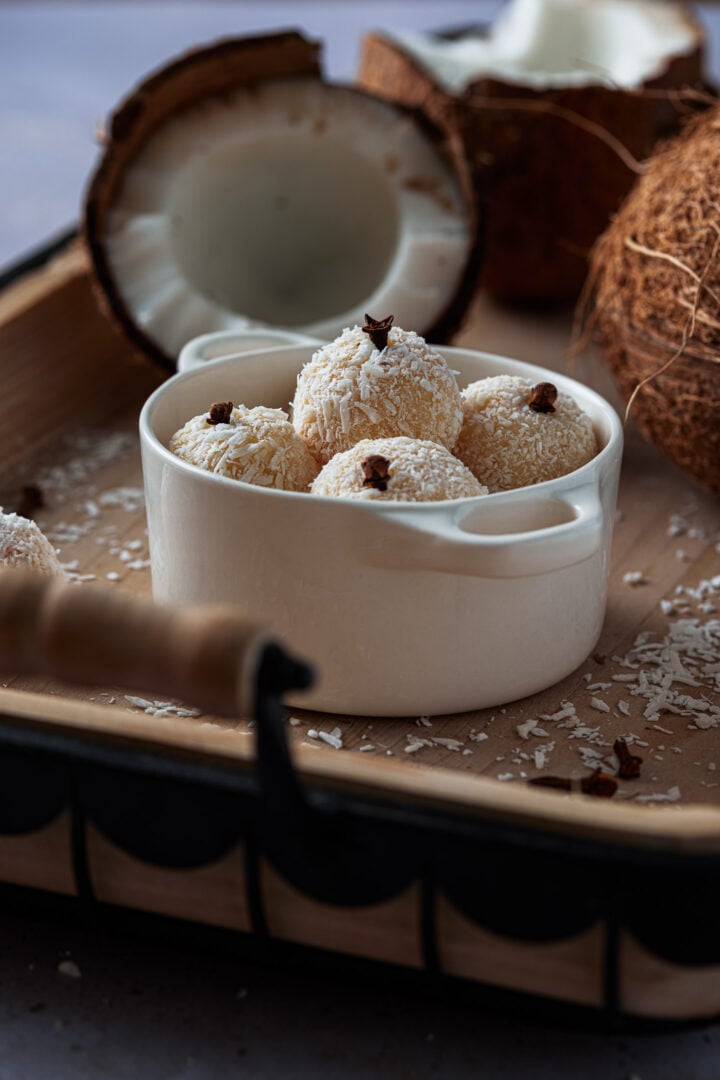
When to Serve Beijinho?
Beijinho can be served on various occasions and is a versatile treat that suits different events. Here are some occasions when this treat is usually served:
- Birthday parties: Beijinhos are a staple at Brazilian birthday parties, especially children’s parties. They are often served alongside other sweets and treats, adding a touch of tropical flavor to the celebration.
- Weddings and celebrations: Beijinhos are frequently included in dessert spreads at weddings and other festive gatherings. They can be served as part of a dessert table or presented in decorative trays or boxes as party favors for guests.
- Holidays and festivals: Beijinho is a popular sweet during holidays and festivals in Brazil. Whether it’s Christmas, New Year’s, Easter, or other festive occasions, beijinhos make a delightful addition to the dessert offerings. You could even decorate them as snowmen or Easter bunnies to fit the occasion.
- Potluck gatherings: If you’re attending or hosting a potluck or a gathering where guests bring dishes to share, beijinhos can be a wonderful contribution. Their bite-sized nature and crowd-pleasing flavor make them a hit at such events.
- After-dinner treats: Beijinhos can be enjoyed as an after-dinner treat or a sweet snack. They provide a small indulgence that satisfies the craving for something sweet without being overly heavy.
- Special occasions: Beijinho can be served on any special occasion or as a delightful treat to celebrate milestones, achievements, or simply to add a touch of sweetness to a memorable moment.
Remember, Beijinho is a versatile sweet that can be enjoyed at any time you desire a little taste of Brazil’s coconut-infused bliss.
Variations
While the traditional beijinho recipe remains a favorite, there are various adaptations and creative twists that incorporate different flavors and toppings. From adding chocolate or nuts to decorating the truffles with sprinkles or toasted coconut, beijinho can be customized to suit different preferences and occasions.
These are some of the variations I’ve encountered throughout the years:
- Beijinho filled with chocolate or Nutella
- Beijinho filled with grapes
- Beijinho de Coco Queimado (Toasted Coconut Beijinho) – made with toasted coconut instead of regular grated/shredded coconut
- Beijinho de Milho Verde (Corn Beijinho) – with the addition of corn, for that flavor combo of corn and coconut that is very beloved by Brazilians
- Low Carb Beijinho – made with coconut milk, heavy cream and sweetener instead of sweetened condensed milk
- Dairy Free or Vegan Beijinho – made with coconut milk-based sweetened condensed milk
The mixture of beijinho is also commonly used as an ingredient in other recipes, such as a filling for cakes and chocolate truffles.
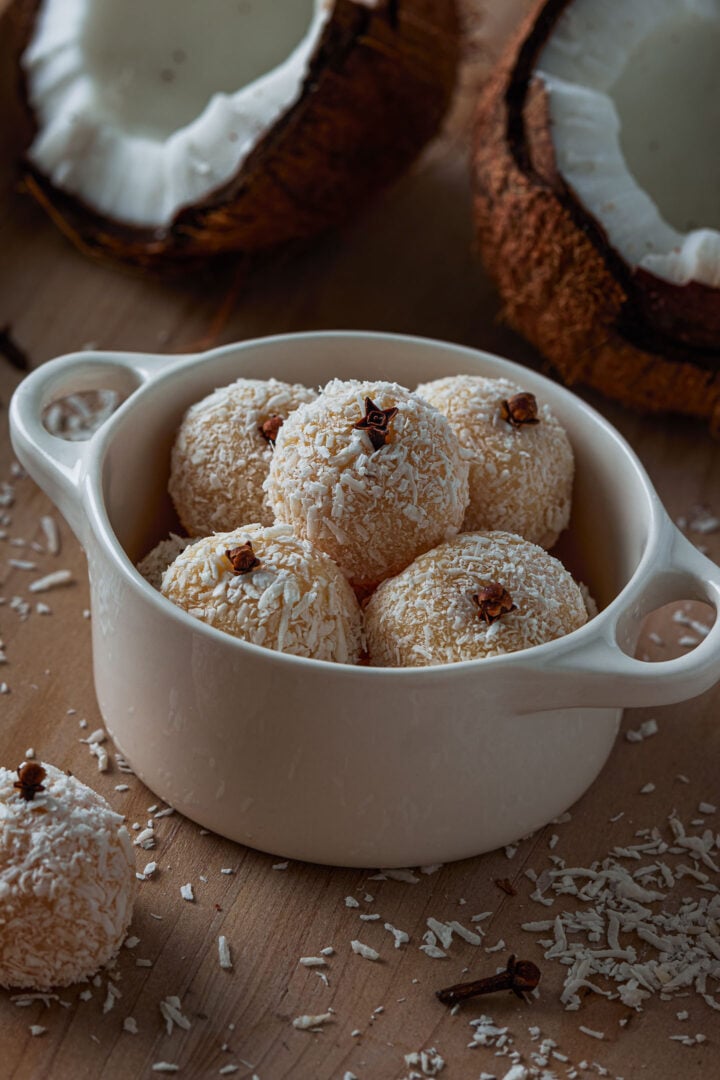
Storage
Beijinhos will keep at room temperature, in an airtight container, for up to 3 days before they start to dry out. For longer storage, you can keep them in the fridge for about a week, or freeze them for up to 3 months.
If you freeze them, just thaw them in the refrigerator overnight and then allow them to come to room temperature before serving.
Frequently Asked Questions
Yes, beijinhos can be made ahead of time. Once prepared and shaped into balls, you can store them in an airtight container for up to 3 days at room temperature or up to a week in the fridge. Just remember to let them come to room temperature before serving for the utmost creaminess!
How long does it take to make beijinho?
The cooking and preparation time for these treats is relatively quick. It usually takes around 15-25 minutes to cook the mixture and shape the beijinhos, depending on the cookware and batch size.
Yes! Just substitute the butter with a non-dairy alternative like coconut oil or vegan margarine. Ensure that the sweetened condensed milk you use is also dairy-free or vegan-friendly. Coconut milk-based sweetened condensed milk is a popular option for vegan beijinho.
Absolutely! While traditional Beijinhos are often decorated with grated coconut and cloves, you can get creative with other toppings and decorations. Consider rolling them in sprinkles, or finely chopped nuts. Edible glitter or colored sugar can also add a festive touch.
More Brazilian Recipes
- Brazilian Carrot Cake
- Brazilian Flan
- Manjar Branco (Coconut Flan)
- Pão de Mel (Brazilian Honey Cakes)
- Passion Fruit Mousse
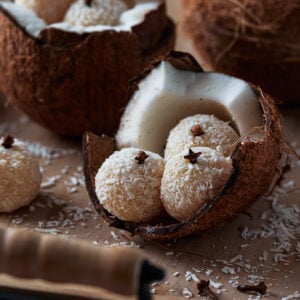
Beijinho (Brazilian Coconut Balls)
Ingredients
- 1 can (14oz/396g) sweetened condensed milk
- 1 ⅓ cups (100g) unsweetened grated coconut
- 1 tablespoon unsalted butter, plus more for greasing plate and hands
- Grated coconut for rolling
- Whole cloves for decorating
Instructions
- In a medium-sized saucepan or small Dutch Oven, combine the sweetened condensed milk, grated coconut and butter. Cook, over medium-low heat, for 10-20 minutes or until the mixture thickens. You will know it's ready when you run a rubber spatula through the middle of the mixture and it leaves a trail, taking a while for it to come back together. If you prefer the use a thermometer, the beijinho is ready at around 190º-200ºF (88º-95ºC).
- Transfer the mixture to a plate that has been generously greased with butter, spreading it into a single layer. Cover with plastic wrap and let it cool completely.
- Once the beijinho mixture has cooled, grease your hands with butter and form smooth balls with about 1 tablespoon of mixture, about the size of a cherry. This recipe will yield about 20 to 25 beijinhos.
- Place some grated (or shredded) coconut in a plate. Roll the balls through the coconut, then insert a clove in the middle.
- Serve the beijinhos as-is or in small paper cups. If your guests are not familiar with them, remind them to remove the cloves before eating!


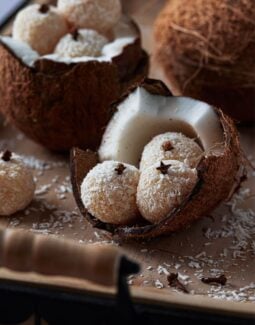
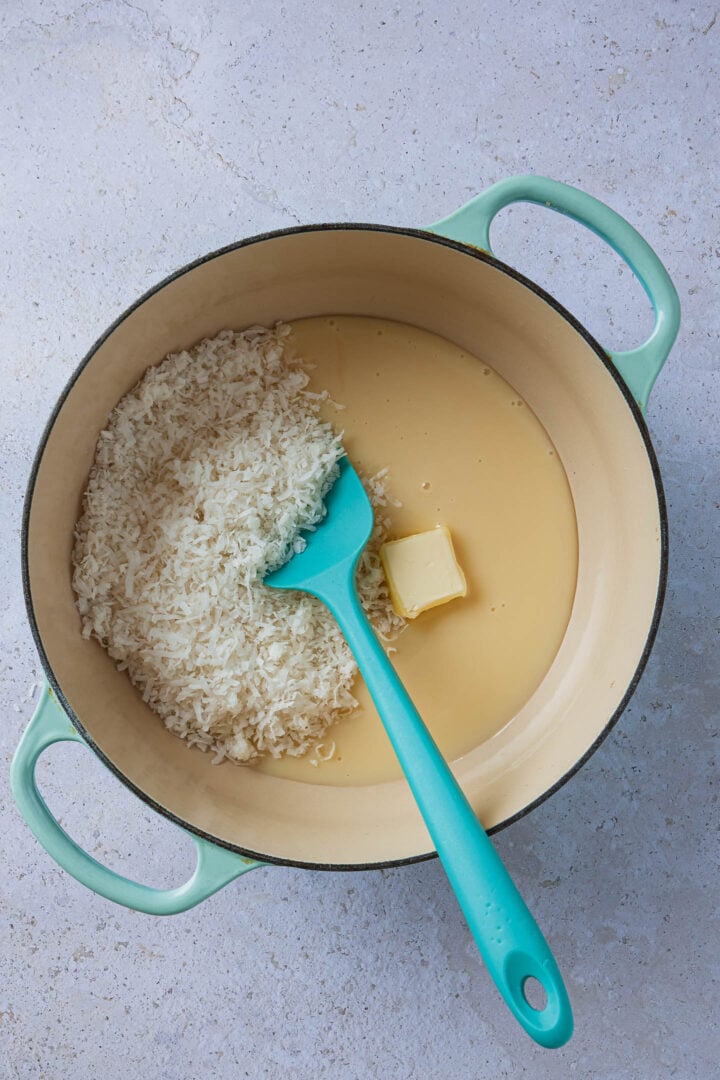
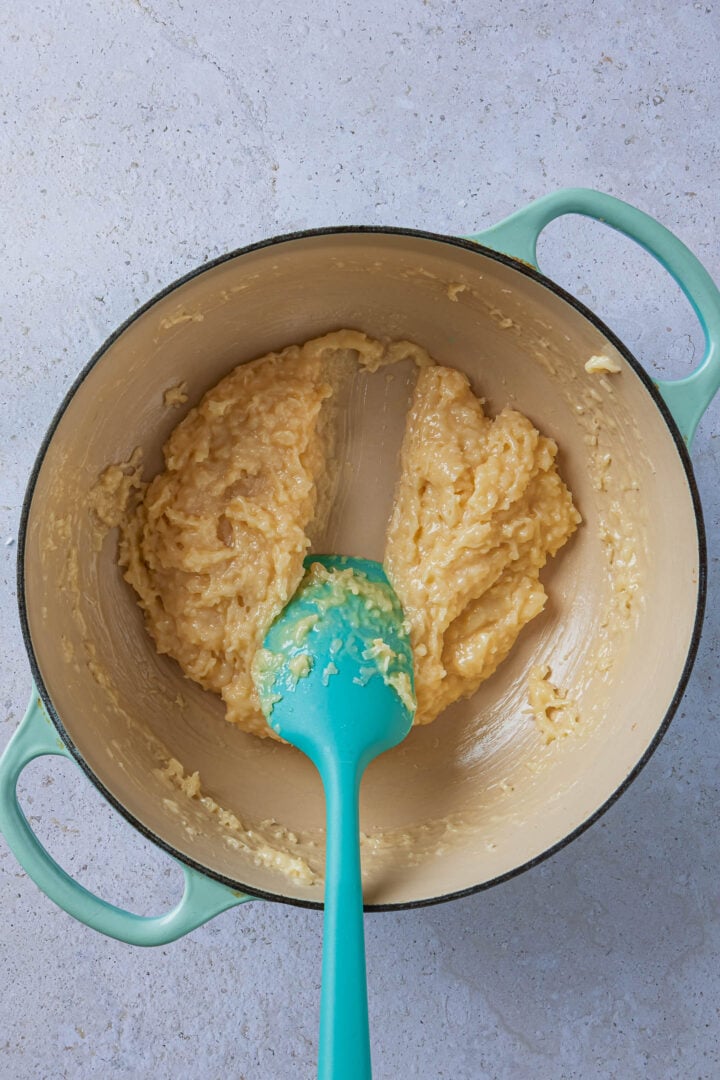
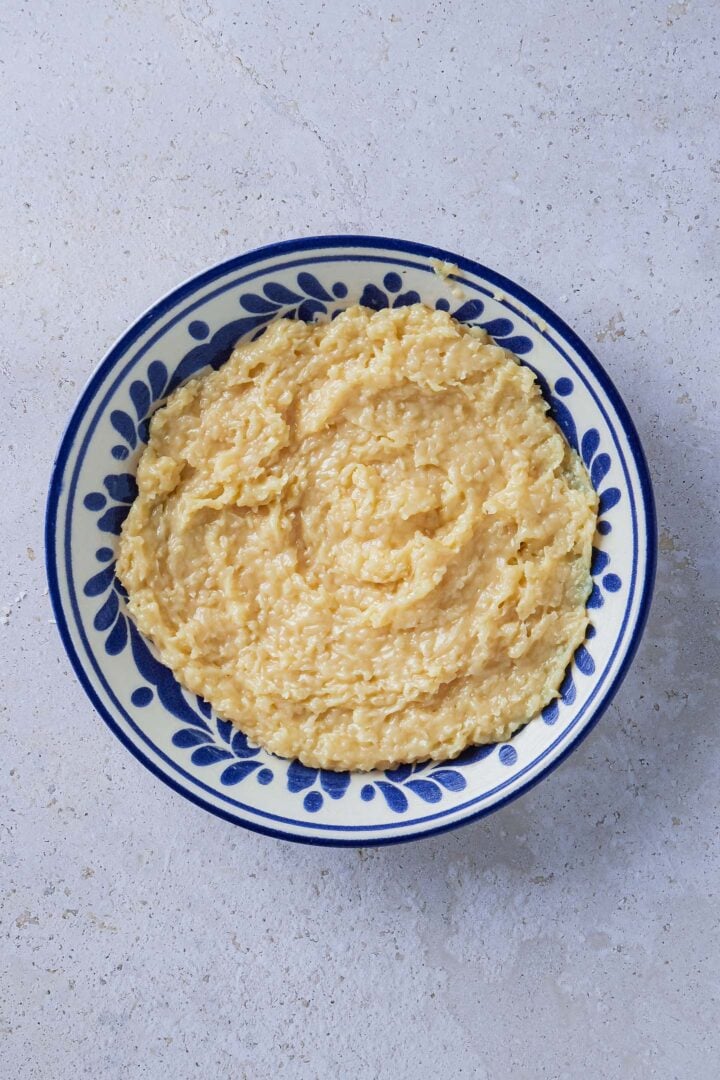
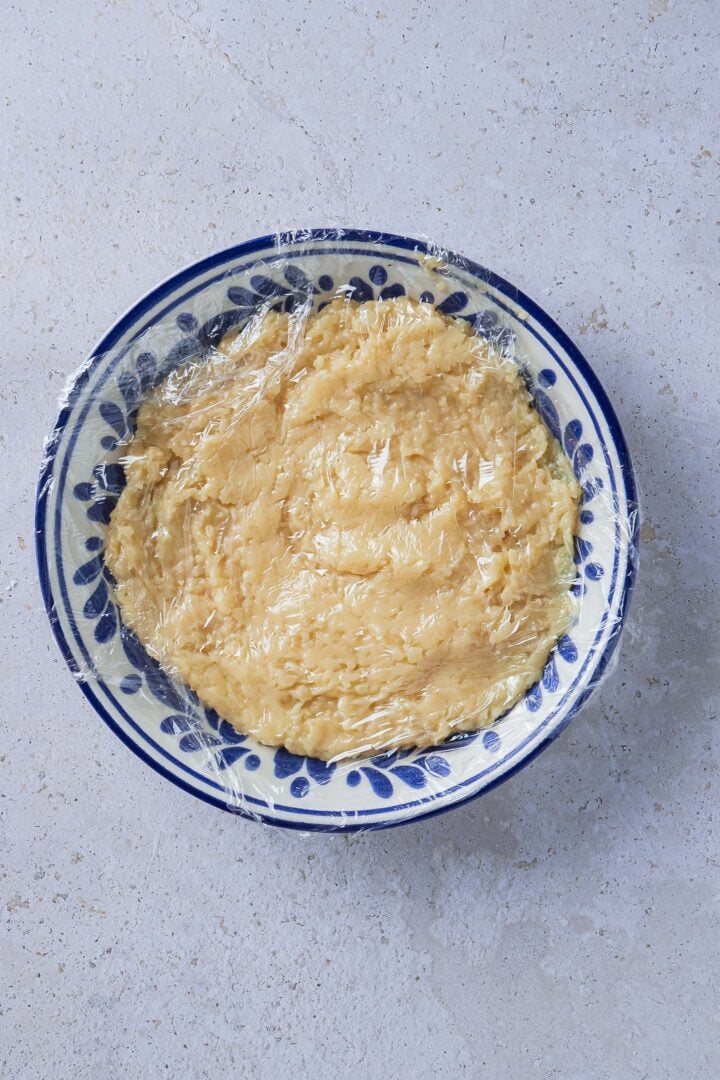
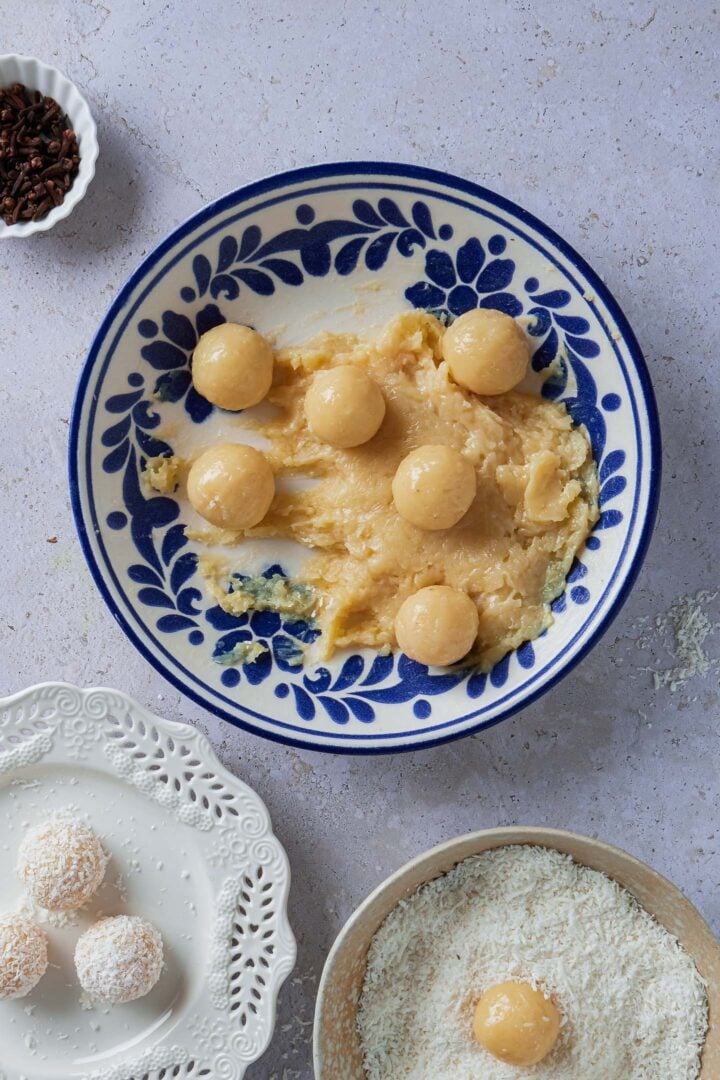
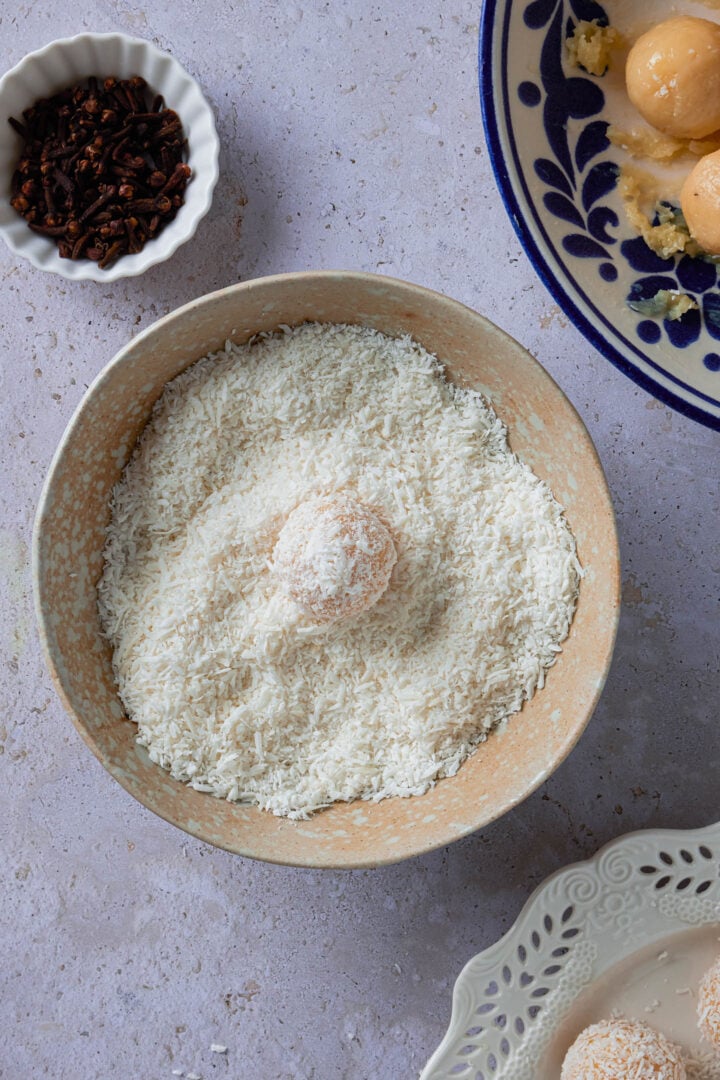
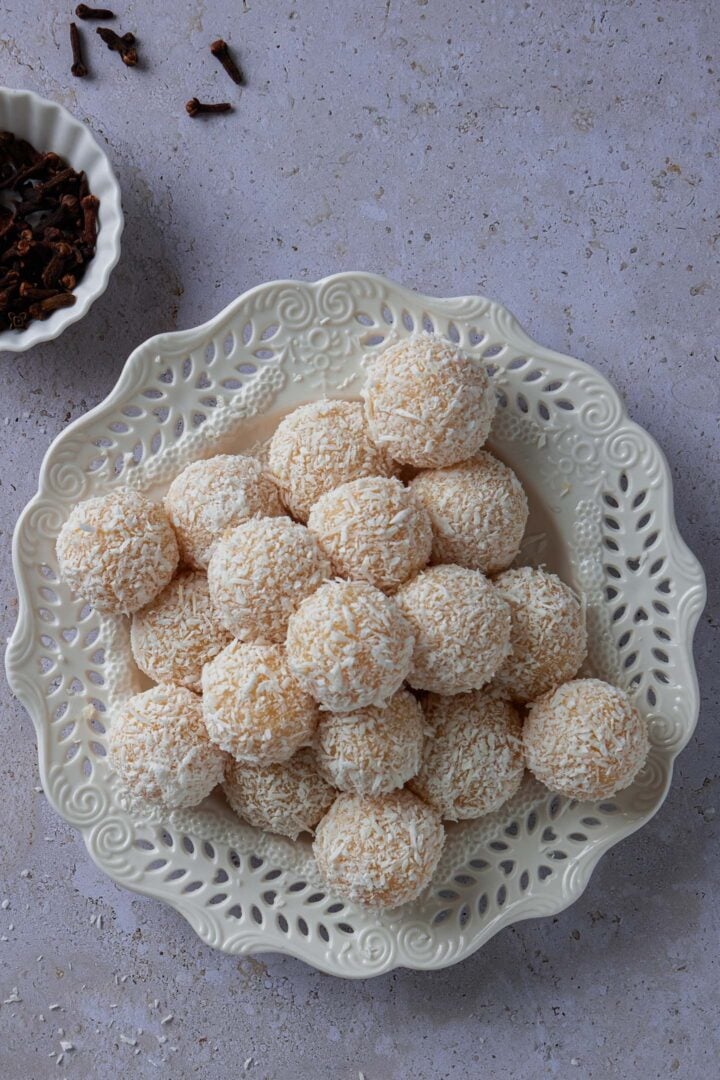
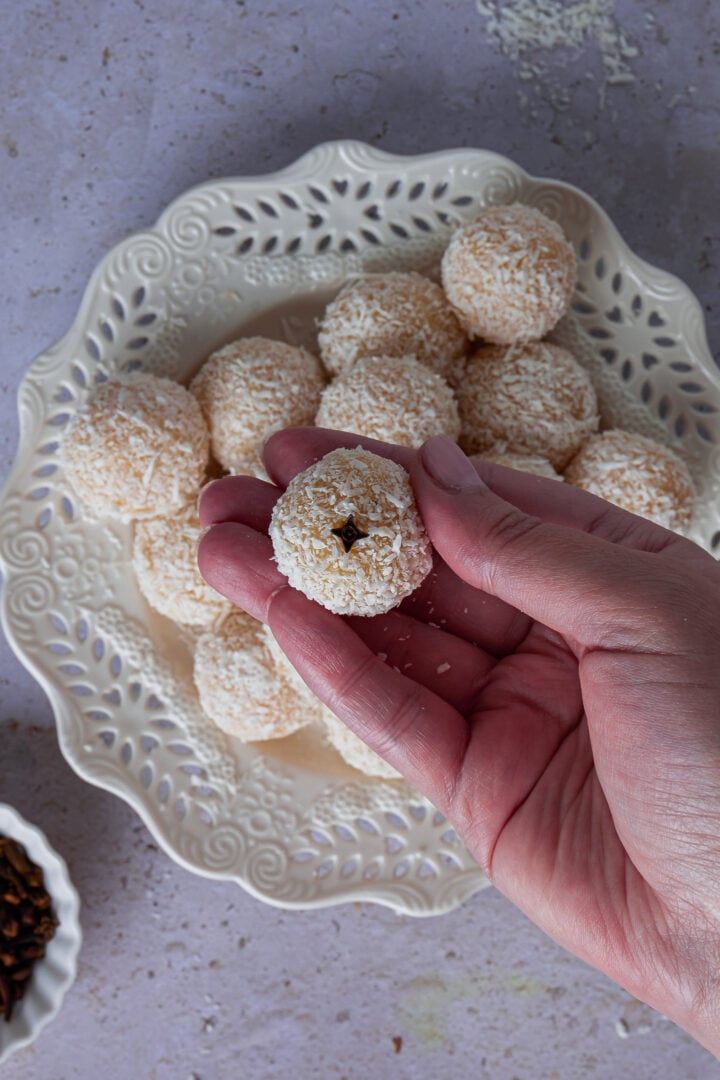
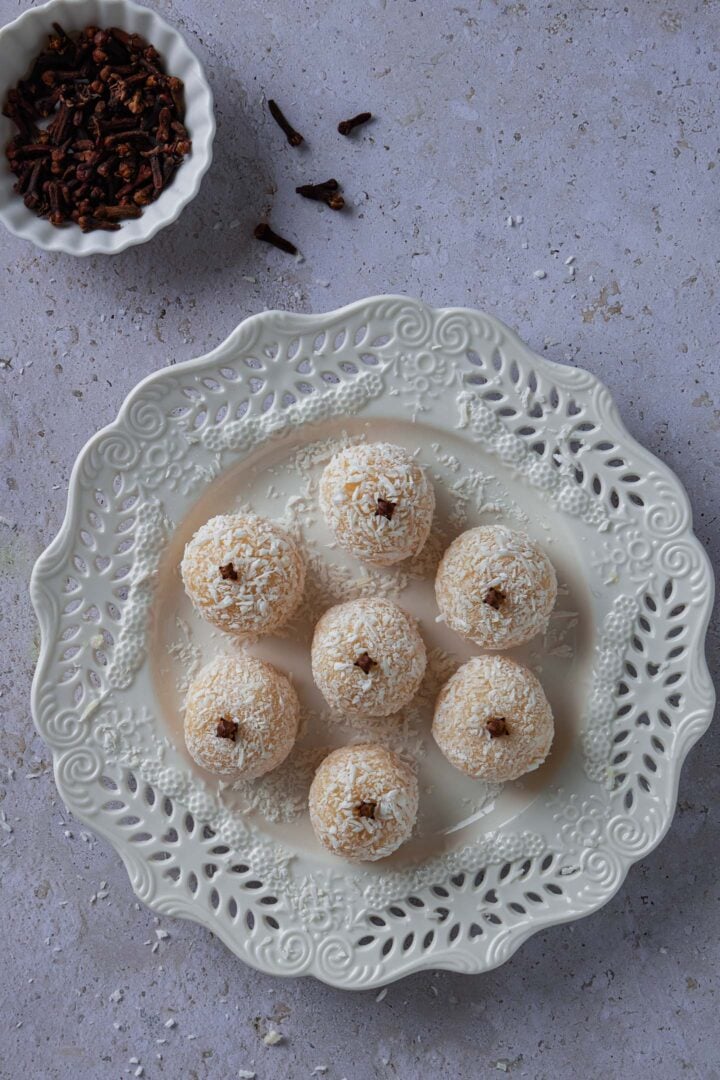


3 Comments on “Beijinho (Brazilian Coconut Balls)”
lo mejor
Beijinhos also taste amazing with a hint of cinnamon
I’ll have to try that next time! 😊